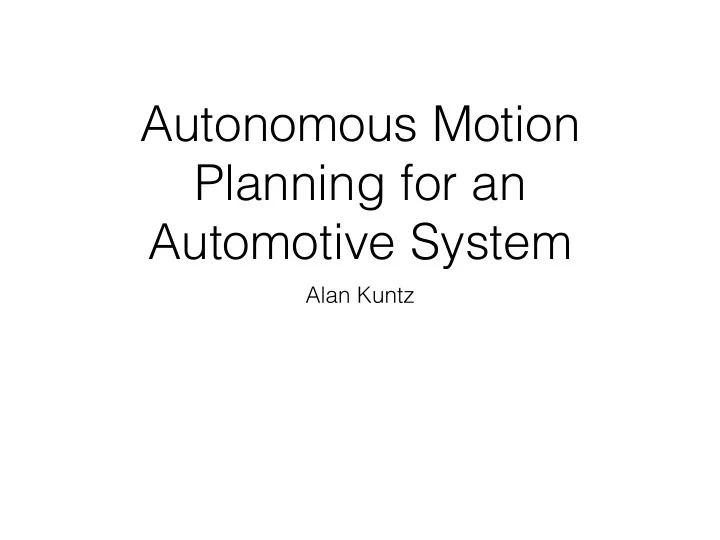

Autonomous Motion Planning for an Automotive System Alan Kuntz
Autonomous Driving in Urban Environments: Boss and the Urban Challenge http://onlinelibrary.wiley.com/doi/10.1002/rob.20255/epdf
Chris Urmson, Joshua Anhalt, Drew Bagnell,Christopher Baker, Robert Bittner,M. N. Clark, John Dolan, Dave Duggins, Tugrul Galatali, Chris Geyer, Michele Gittleman, Sam Harbaugh, Martial Hebert, Thomas M. Howard, Sascha Kolski, Alonzo Kelly, Maxim Likhachev, Matt McNaughton, Nick Miller, Kevin Peterson, Brian Pilnick, Raj Rajkumar, Paul Rybski, Bryan Salesky,Young-Woo Seo, Sanjiv Singh, Jarrod Snider,Anthony Stentz, William “Red” Whittaker, Ziv Wolkowicki, Jason Ziglar,Hong Bae, Thomas Brown, Daniel Demitrish, Bakhtiar Litkouhi, Jim Nickolaou, Varsha Sadekar, Wende Zhang, Joshua Struble, Michael Taylor, Michael Darms, and Dave Furgeson
Boss
Getting from Start to Goal • Mission Planning • Behavioral Reasoning • Motion Planning
Mission Planning • Graph Search • Blockage Detection
Behavioral Reasoning • Intersection and Yielding • Distance Keeping and Merge Planning • Zone Planning • Error Recovery
Motion Planning • Structured • Unstructured
Mission Planning • Graph Search • Precomputed Graph • Vertices represent goal locations • Edges represent things like lanes
Edge Weights • Combination of several factors: • Expected time of traversal • Edge length • Complexity of environment • Updated in real time • Blockages • Replan
Blockages • Detected Blockages • Sensed static obstacles • Knowledge decays over time • Virtual Blockages • Motion planner fails • Forgotten at each checkpoint
Mission Planning • Feeds navigation information to Behavioral Reasoning unit including: • Intersection information • Lane information
Behavioral Reasoning
Behavioral Reasoning
Intersection Handling • Observes model of intersection • Computes vehicle precedence • Actively gathers data (movable sensors) • Acts when has highest precedence
Precedence
Precedence for Yielding
Distance Keeping • Attempts to match the velocity of the vehicle in front of it • Positive acceleration proportional to velocity difference • Negative acceleration fixed parameter • Maintain a desired vehicle gap • One car length per 10 mph, or minimum gap
Lane Merging
Motion Planning • Structured • Lane following • Merging • Intersection handling • Unstructured • Parking lot navigation • Error recovery (dead vehicle, fallen tree, etc)
Structured Motion Planning • First a trajectory is constructed • Center line of lane • Virtual lane • Merging path • Perturbations of trajectory planned • Smooth • Sharp
Perturbations of Trajectory
Trajectory Generation • Howard, T.M., and Kelly, A. (2007). Optimal rough terrain trajectory generation for wheeled mobile robots. International Journal of Robotics Research, 26(2), 141–166.
Trajectory Generation • Vehicle model: • Curvature limit (minimum turning radius) • Curvature rate of change limit (how quickly the steering wheel can be turned) • Maximum acceleration and deceleration • Control input latency model
Trajectory Generation • Boundary Value Problem • Control parameterized • Velocity profiles • Spline parameters
Trajectory Generation
Trajectory Generation • Initial trajectory is iteratively improved • Jacobian numerically evaluated in parameter space • Gradient decent • Iterates until boundary constraints within threshold or divergence
Trajectory Evaluation
Unstructured Motion Planning • Motion goal is pose within a zone • No predefined paths
Lattice Planner • 4D state space (x, y, θ , v) • Anytime D* • Likhachev, M., Ferguson, D., Gordon, G., Stentz, A., & Thrun, S. (2005). Anytime dynamic A*: An anytime,replanning algorithm. In Proceedings of the Fifteenth International Conference on Automated Planning andScheduling (ICAPS 2005), Monterey, CA. AAAI.
Anytime D* • Uses a discretized (multi resolution) state/control space • Heuristic search from goal pose to current pose • Initial trajectory, improved over time with extra computation (bounds on sub optimality) • Able to adapt to sensor input
Anytime D* • Plans around static obstacles • Bias paths away from dynamic obstacles • Paths are followed using a similar local planner as structured motion planning presented earlier • Leverage preplanning
Anytime D*
Anytime D* • Also see: • http://www.cs.cmu.edu/~maxim/files/ motplaninurbanenv_part2_iros08.pdf
Getting from Start to Goal • Mission Planning • Adaptive high level graph search • Behavioral Reasoning • State based reasoning system • Motion Planning • Optimization or graph based, depending on environment
Thank You
Recommend
More recommend